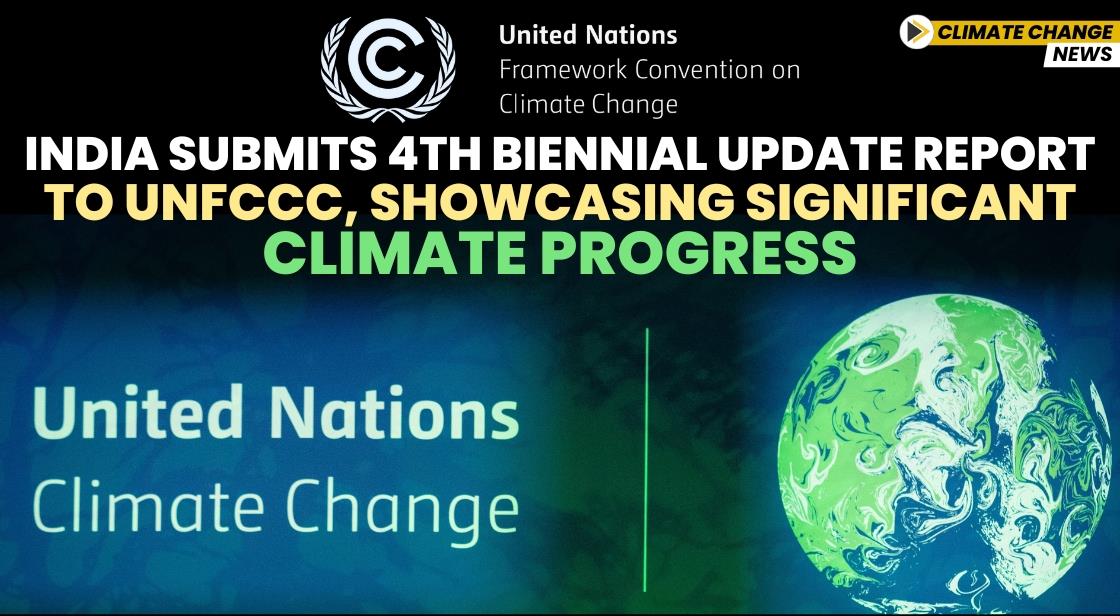India Submits 4th Biennial Update Report to UNFCCC, Showcasing Significant Climate Progress

News Synopsis
On December 30, 2024, India reaffirmed its leadership role in global climate action by submitting its 4th Biennial Update Report (BUR-4) to the United Nations Framework Convention on Climate Change (UNFCCC). This report is an update to the country’s Third National Communication (TNC) and outlines India’s climate progress, focusing on its greenhouse gas (GHG) emissions, sustainability initiatives, and achievements in balancing economic growth with environmental responsibility.
Achievements in Climate Action and Emission Reduction
Union Minister for Environment, Forest and Climate Change, Bhupender Yadav, highlighted India’s strong commitment to sustainable development. In a statement, he emphasized how India’s progress aligns with Prime Minister Narendra Modi’s vision for meaningful climate action and global environmental responsibilities.
India’s BUR-4 reveals a 7.93% decrease in GHG emissions in 2020 compared to 2019. The total emissions, excluding the Land Use, Land-Use Change, and Forestry (LULUCF) sector, amounted to 2,959 million tonnes of CO2 equivalent (CO2e). This reduction showcases India’s ongoing efforts to curb emissions while fostering economic growth.
Role of Forest and Tree Cover in Emission Reduction
India’s forest and tree cover has played a pivotal role in mitigating the country’s carbon footprint. Including the contributions of LULUCF, the report indicates a substantial reduction in net emissions to 2,437 million tonnes of CO2e. In 2020 alone, India’s forests and trees sequestered approximately 522 million tonnes of CO2, offsetting 22% of the country's total carbon dioxide emissions. This milestone underscores India’s commitment to maintaining and enhancing its forest cover as a key strategy for carbon sequestration.
Sectoral Breakdown of Emissions
The energy sector remains the largest contributor to India’s GHG emissions, accounting for 75.66% of the total emissions. Agriculture follows with 13.72%, while industrial processes and product use contribute 8.06%, and waste accounts for 2.56%. These figures underscore the importance of continued efforts to shift toward cleaner energy sources and more sustainable practices in the energy, agriculture, and industrial sectors.
Reduction in Emission Intensity and Economic Growth
One of the key accomplishments highlighted in the report is India’s reduction in emission intensity—the measure of GHG emissions per unit of economic output. Between 2005 and 2020, India achieved a 36% reduction in emission intensity. This signals a successful decoupling of economic growth from environmental impact, reflecting India’s commitment to sustainable development while driving economic progress. This achievement aligns with India’s Nationally Determined Contributions (NDCs) under the Paris Agreement.
Growth in Renewable Energy Capacity
India has also made substantial strides in transitioning to renewable energy. By October 2024, 46.52% of the country's installed electricity generation capacity came from non-fossil sources. The total installed renewable energy capacity, including large hydropower, reached 203.22 GW. Notably, the non-hydro renewable capacity saw a more than fourfold increase between 2014 and 2024, signaling India’s growing reliance on clean energy solutions.
Expansion of Forest and Tree Cover
India’s forest and tree cover continues to expand, contributing to the country’s carbon sequestration efforts. The country’s forest cover now accounts for 25.17% of its total geographical area. Between 2005 and 2021, these efforts helped create an additional carbon sink of 2.29 billion tonnes of CO2 equivalent. This progress highlights India’s ongoing commitment to increasing its green cover as part of its comprehensive climate strategy.
India’s Approach to Climate Equity
Despite contributing minimally to historical global emissions, India’s climate actions reflect a commitment to the principles of equity and "Common but Differentiated Responsibilities and Respective Capabilities" (CBDR-RC). These principles, enshrined in the UNFCCC and the Paris Agreement, guide India’s efforts to address climate change, balancing national development goals with global climate responsibilities. India’s actions demonstrate its determination to mitigate climate challenges while respecting the right to sustainable development.
Conclusion: India’s Leadership in Global Climate Action
India’s 4th Biennial Update Report demonstrates the country’s unwavering commitment to addressing climate change and making significant progress in reducing emissions. By enhancing its renewable energy capacity, expanding its forest cover, and reducing emission intensity, India is moving closer to its climate goals while promoting sustainable development. The country’s actions also align with the global climate agenda, positioning India as a key player in the fight against climate change.
You May Like









